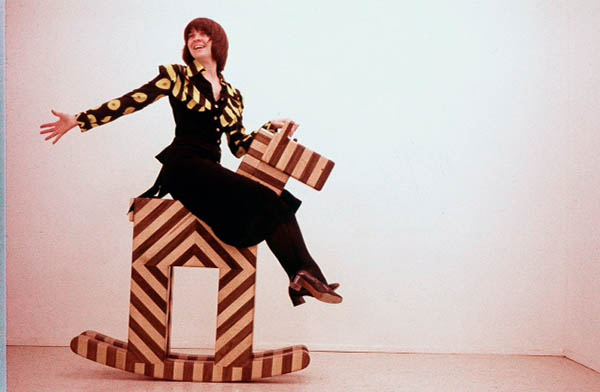
Next month, an exhibit will open at Los Angeles’s Craft in America Center offering a retrospective on Pamela Weir-Quiton’s 50-year (so far) body of work.
That woodworking journey was not the original plan – Pamela, in fact, had wanted to study fashion ever since taking sewing classes with her mother after the purchase of a new Singer sewing machine in 1955. Pamela was 11 then.
As a college student at California State University Northridge in the 1960s, however, she was an art major focusing on ceramics. Ralph K. Evans, the woodshop teacher, was her advisor. “At one of our consulting meetings, he said, ‘Look at you; you’re covered in clay. Why don’t you come into the woodshop and get covered in sawdust?’ I had picked him from the lineup of art teachers because he looked like Steve McQueen and I thought, ‘Well, I could probably do that for a class or two.’”
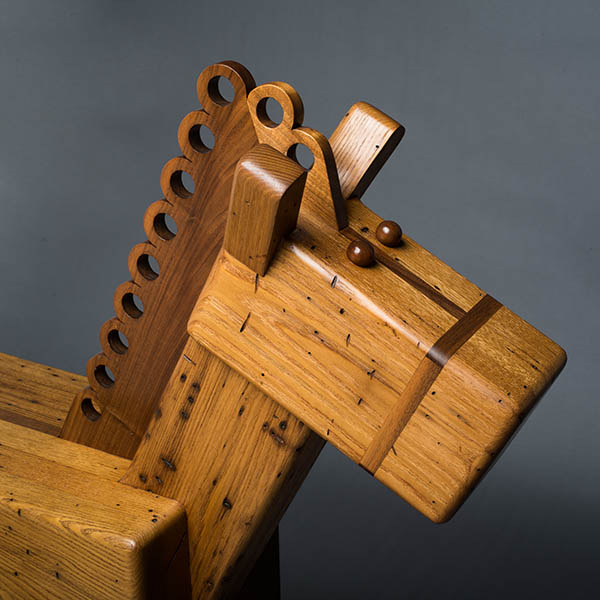
The first assignment in the wood class was to make a doll or a toy by laminating different types of exotic hardwoods. The class took a field trip to L.A.-area lumberyard Rare Woods, “And when I got there, the hair on my arms stood up, and I fell in love with exotic hardwood,” Pamela said.
She based her doll for the project on a doodle sketch she’d done for designing clothes, following it up for the next assignment, a pull-apart toy, with four different dolls which had interchangeable parts, and eventually creating a group of 144 dolls, 12 each in 12 different styles, inspired by what she was seeing from fashion designers like Mary Quant and Betsey Johnson “and the whole kind of Sassoon haircut and miniskirts and boots.”
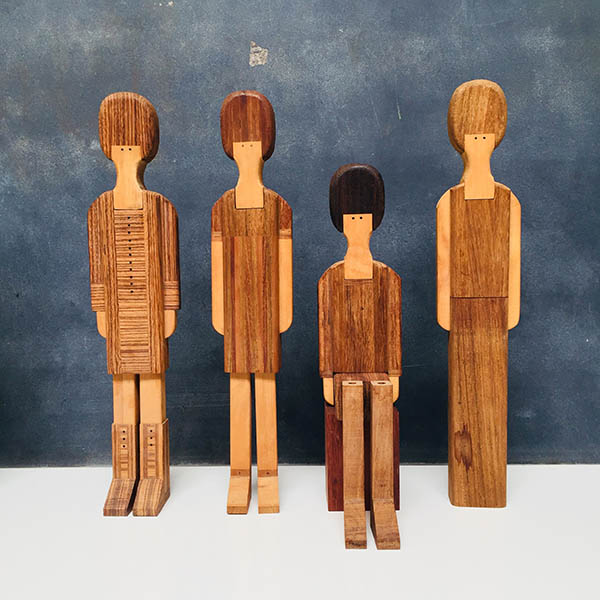
At Cal State Northridge, “They never tried to make you do what they wanted you to do; I was totally encouraged and free to do my dolls and just totally, totally supported out there,” Pamela said. Those wooden dolls were the beginning of her professional woodworking: some were featured in a student exhibit at a museum, in area newspapers sold at Los Angeles’s Craft and Folk Art Museum, and a version was featured in 1968’s California Design 10 exhibition curated by Eudorah Moore.
That version was the third semester assignment in the college woodshop classes: to make a piece of furniture. “The boys all made stereos, and the girls all said, ‘We’re going back to ceramics. We’ve turned our wooden bowls, and we’re done with wood. But there I was.” At the suggestion of her teacher, she created lifesize versions of her dolls as chairs – with extras. “I thought, ‘If I make 6-foot wooden doll, it’s going to be really heavy, and it’s going to be really expensive for my parents to buy this wood. So I’ll make it hollow. I’ll make a series of boxes, put them together. And then I thought, ‘Well, that’s going to be wasted space, so I’ll make drawers and hinges and secret compartments, so that’s what I did. And I landed, me and my two dolls landed, on the cover of the L.A. Times Sunday Home magazine.”
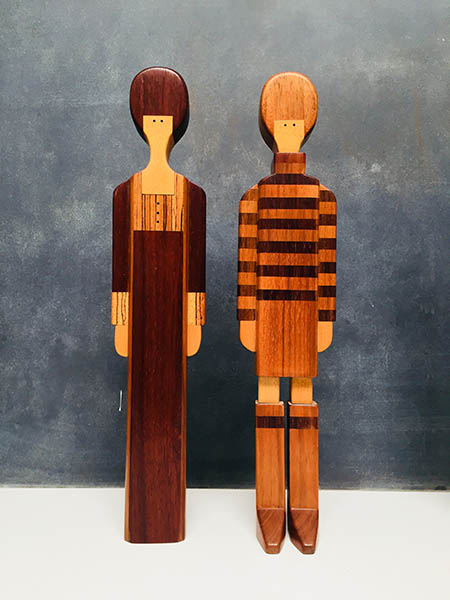
At that point, Pamela was working as a fashion designer for Denise Designs and, coincidentally, also had a dress she had designed featured on the cover of Seventeen magazine. “The woman I was working for said, ‘You have got to pick. You’ve either got to do clothes or wood.’ And she said, ‘When you look at a telephone pole, I want you to see Denise dresses.’ And I thought, ‘When I look at a telephone pole, I see wooden dolls.’ So I chose.”
“All of a sudden, I was a woodworker,” Pamela said. With a loan from architect and collector clients, she set up a 5,000 square foot shop in Venice, California, and purchased basics including a Rockwell table saw and some hand tools – she used the band saw and other equipment at Cal State Northridge. She maintained that shop/studio for over 40 years, until a recent move to a 4,400 square foot shop in Los Angeles’s West Adams neighborhood.
An acquaintance of Sam Maloof and Wendell Castle, Pamela describes herself as a mid-Century woodworker. Although her work is difficult to categorize, she said, “I have stayed true to my original idea in the realm of Sam Maloof and George Nakashima, who hit upon a style early on and stayed with it.” In her case, “It’s like everything I’ve done has been about playing.”
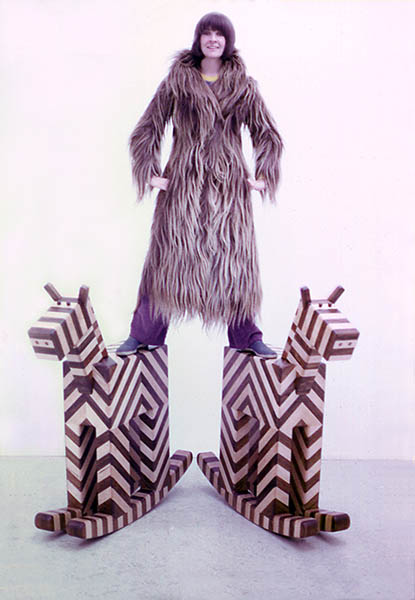
That includes adult-size rocking animals, department store window displays and animal-themed playgrounds for indoor shopping centers, as well as the dolls – “I call them dolls because the assignment was, ‘make a doll or a toy,’” Pamela said. With the retrospective, she noted, “I’m seeing that my work is valuable and worthwhile, whereas it may have been written off as ‘girl stuff’ or ‘dolls.’ I think they are equal to almost anything I can think of that I think has a big career.”
While Pamela doesn’t feel that she has experienced overt discrimination in her woodworking career, “I wasn’t accepted in the way that the guys were. I think there were things that didn’t happen, and definitely the prices that I could get didn’t happen because I wasn’t a man. Now I’m hoping to correct and change and shift that.”
She’s also hoping to find a museum home for her circus of tigers that used to form the indoor playground at a Thousand Oaks, California, indoor shopping center. Inspired by the Jungleland animal theme park that used to exist in the area, as well as its tiger trainer, Mabel Stark, the playground is “like if kids were playing with these little toys, and then they went to sleep and started dreaming about playing and the toys became life-size,” Pamela explained.
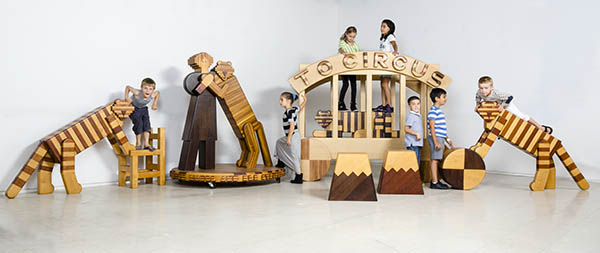
Her other indoor playground installations were also inspired by the sites where they were located: a herd of black and white dairy cows, “Moodesto,” for a site in Modesto, and several animals, including a cat, camel and elephant, with racing numbers for a site near the racetrack in Santa Anita.
The racing animals, Pamela said, are where she started developing her doweling system. “I thought, ‘These ears cannot come off, ever. So I had to make things that could be in a public place with children climbing on them for years that would hold up.” She explained, “I love to slice a dowel horizontally, I mean along the length, so that they give a little so that things fit. The technique I’ve developed myself over the years is, if I’m putting two boxes together to make a body, the doweling and the holes for the doweling will look like a Chinese checkerboard, lots of holes and lots of dowels. And my things can really go together.”
In some ways, Pamela said, “I see how sewing has really influenced how I work in wood and the methods I developed. I love to mark and measure. I love to drill holes. I love to put dowels in the holes.” Inserting dowels into the holes, she said, “is like putting the thread through the hole.”
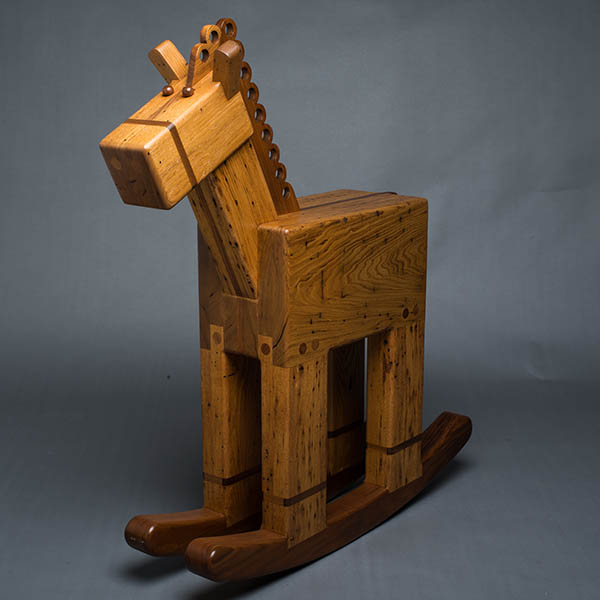
She also draws her full-size patterns on four-foot wide sewing pattern paper, marked with one-inch grids, that she discovered while working for the dress designer. “When I was sewing, you would buy the fabric, and you would have the pattern, and it always seemed like you hadn’t quite bought enough fabric, so it was always like ‘Uh! Where am I going to put the facing for this collar?’ or ‘How am I going to fit this sleeve in?’ It wasn’t just like bada-bing, you lay out this pattern and cut it out. The same for me with wood. When you go and buy lumber, the board is only so long. And the next board might be the same color, but the grain might not be the same. So I started realizing that, ‘Oh, if I’m making a nice rocking horse, I need to make sure that the top is the nicest piece and the sides are also nice, and I need to wrap the wood going around the body.’”
Laying out the pattern pieces on the project helps with this, as does Pamela’s affinity for precision. “I’m not interested in doing something fast and quick and haphazard,” she said. Even with recent efforts to create temporary bases out of scrap wood for some of her dolls, she finds that, for her, “the wood has to be flat, it has to be square,” she said.
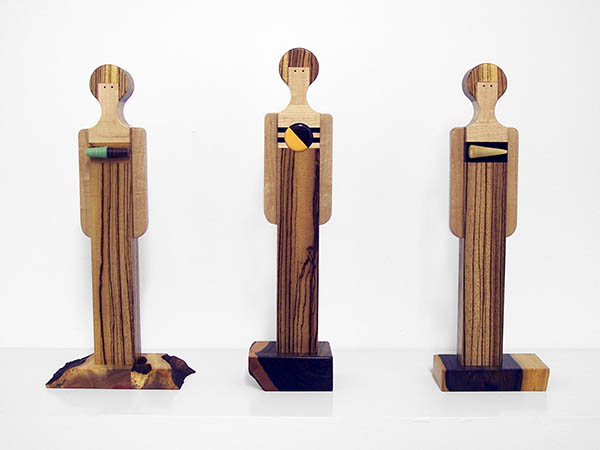
For her wood choices, “exotic hardwoods just rings my bell,” Pamela said. Although some of her early work was done in purpleheart and Osage orange, the original bright purple and bright yellow colors have faded over the years, so she currently prefers to use woods with greater contrast. She has a stockpile of ebony sticks and also likes lacewood, leopardwood, zebrawood, as well as purpleheart. She also considers walnut a basic and, for a lighter wood, “I only use white maple now. I started out using birch, but it turns sort of yellow. Early on, I discovered I didn’t like that. I figure the time it takes, I really want to work with the materials that just give me goosebumps when I see them.
“My hair on my arms still goes up when I discover new things, which is almost daily in the woodshop,” Pamela said. “It’s weird looking back and realizing it’s been 50 years. My body feels 74, but my attitude doesn’t, and I’m still working and I want to keep going. With this retrospective, I’m starting to see my work from the outside instead of just doing it. I think [my pieces] are authentic, and the commitment over 50 years is amazing, looking back. I love the process, and I feel blessed to have fallen into this wood thing.”
The exhibition Made to Play: A Retrospective of Wood by Pamela Weir-Quiton will be on display at the Craft in America Center in Los Angeles from October 13 to December 1, 2018, with an artist talk, studio visit and artist-led book discussion also scheduled.







